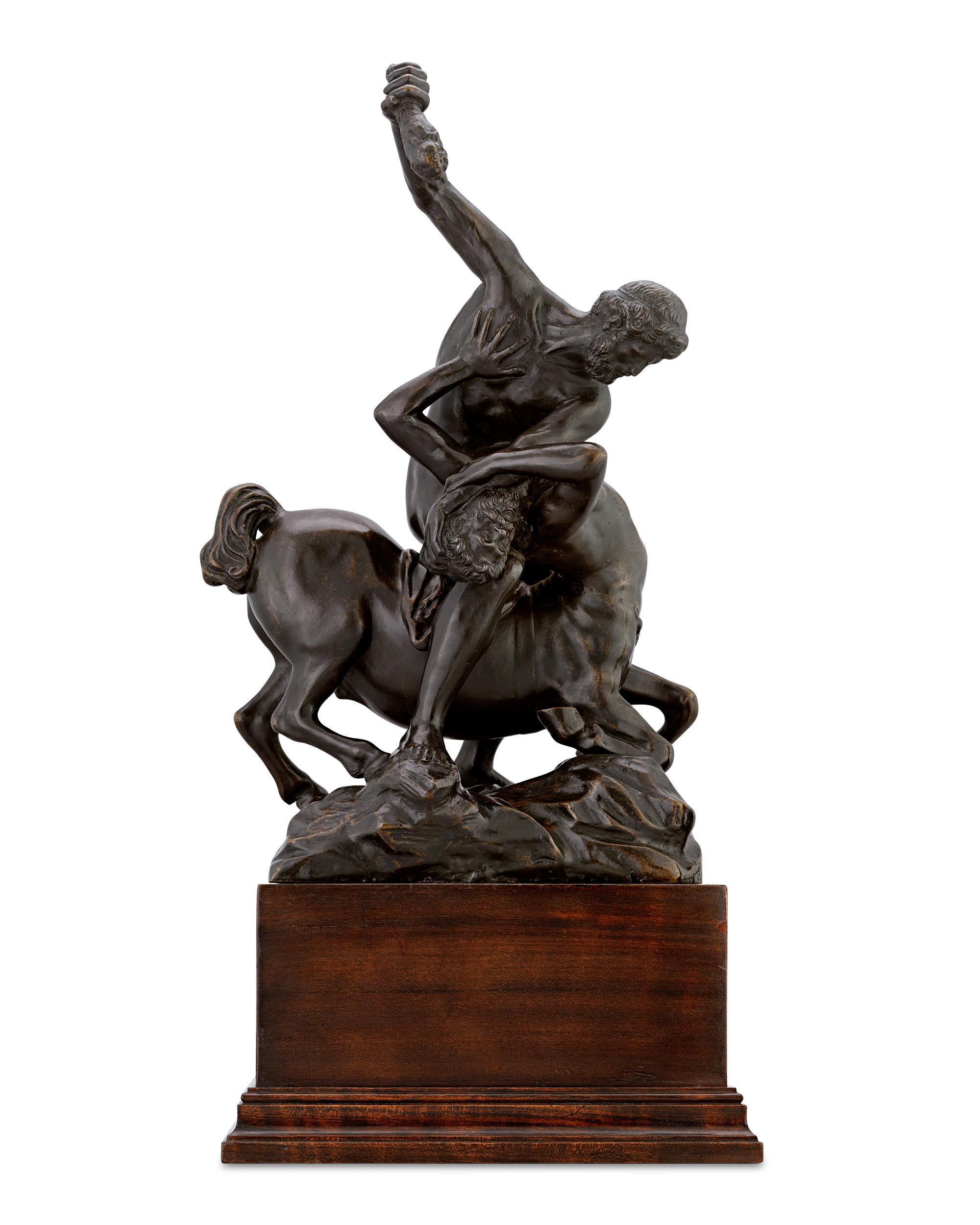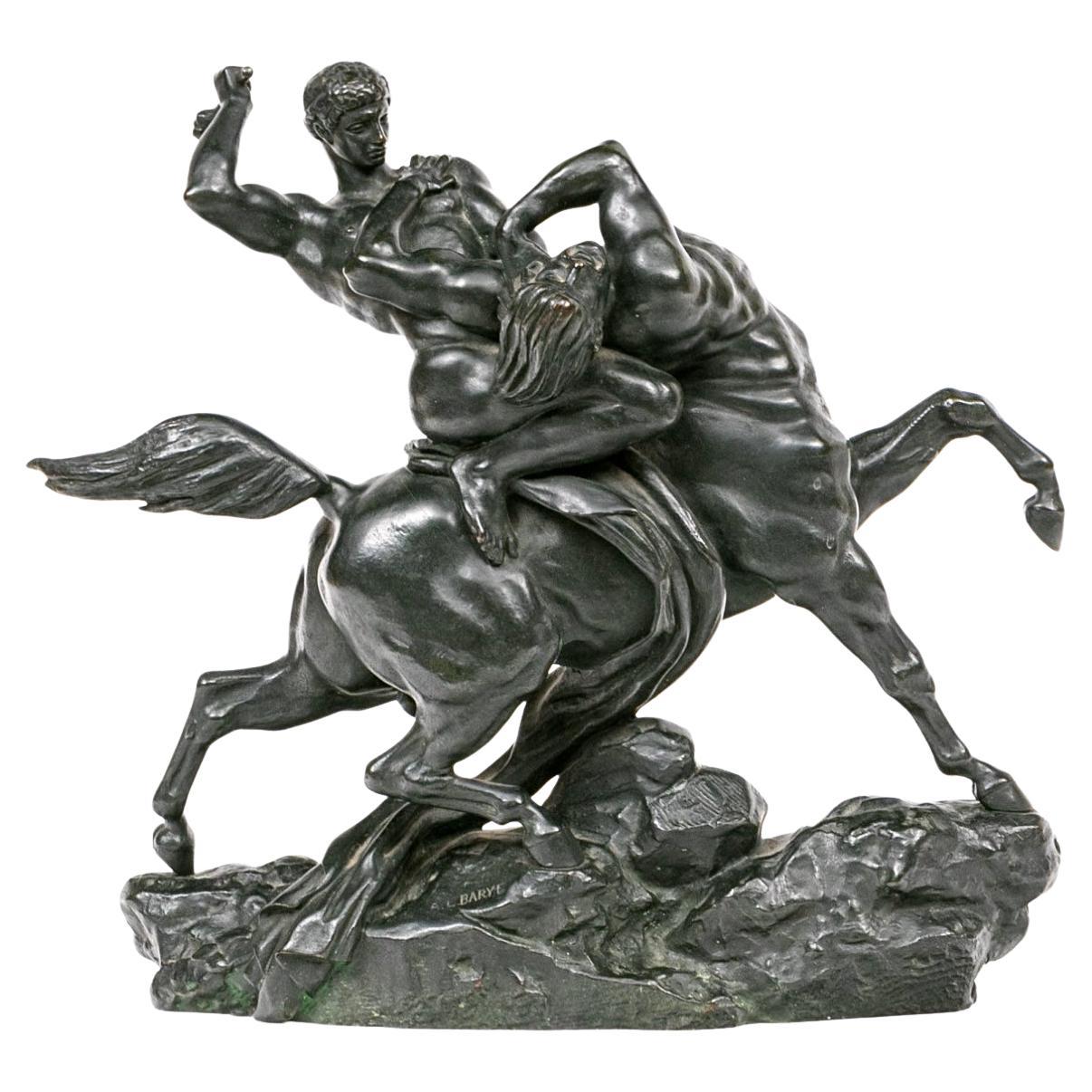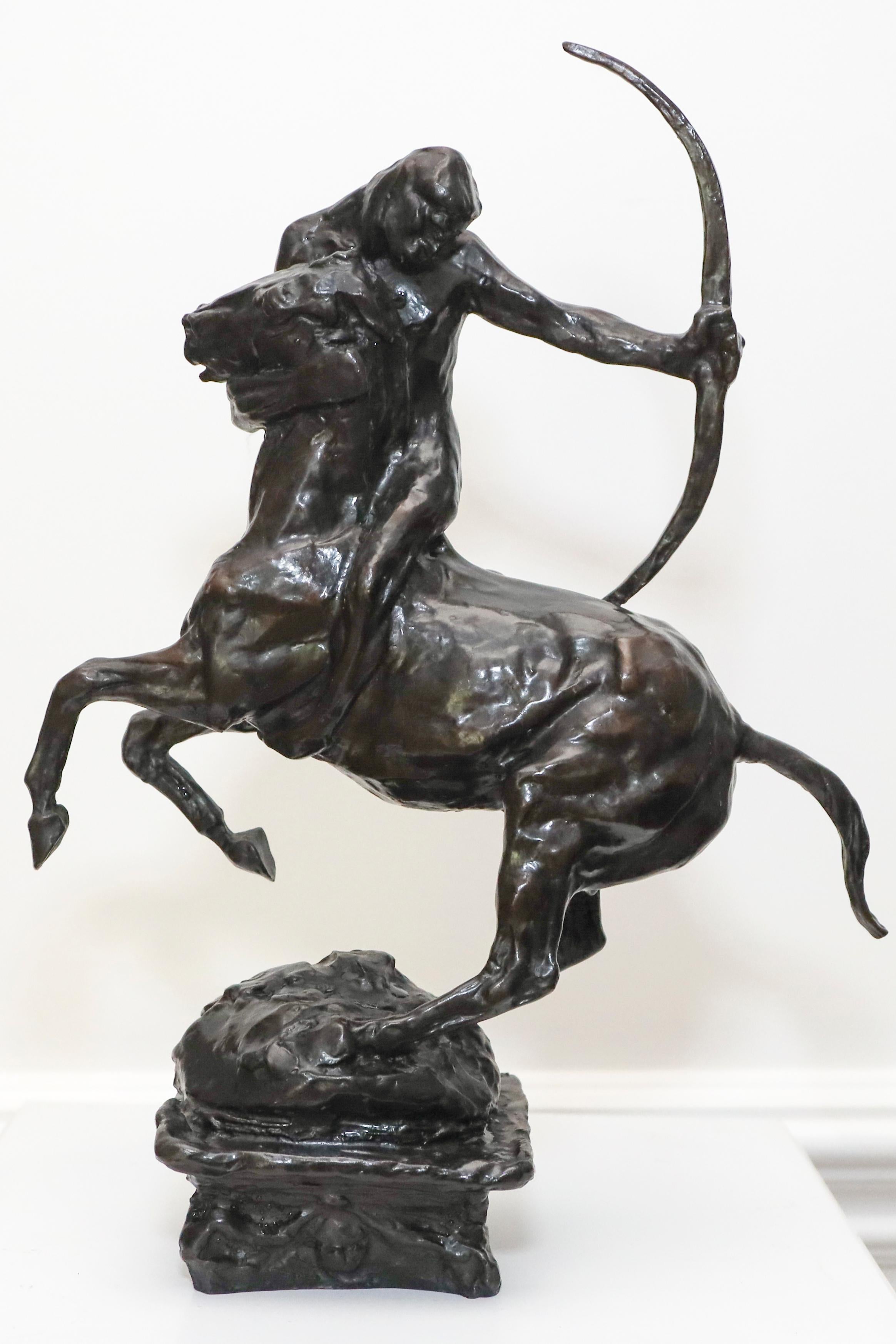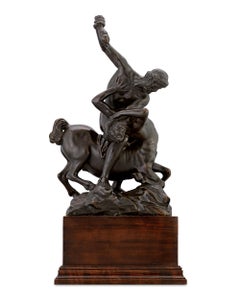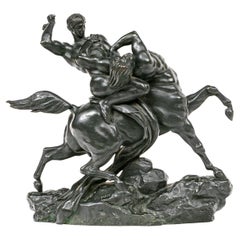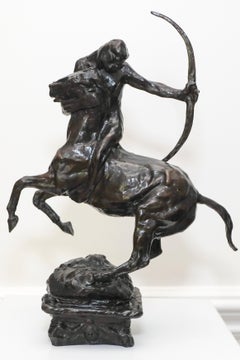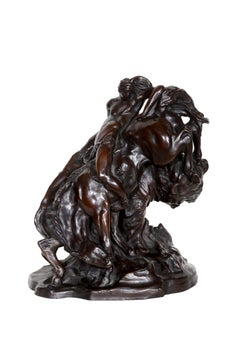Articles similaires à Centaure enlevant une femme
Vous voulez plus d'images ou de vidéos ?
Demander au vendeur plus d'images ou de vidéos
1 sur 15
Aimé-Jules DalouCentaure enlevant une femmevers 1895-1902
vers 1895-1902
27 000 €TVA incluse
À propos de cet article
Centaure enlevant une femme
par Aimé-Jules DALOU (1838-1902)
Sculpture de groupe en bronze à patine brun foncé
Signé sur la base "Dalou"
Distribution par "A.A. Hébrard" (avec le cachet de la fonderie)
Les moulages d'Hébrard sont toujours les plus beaux de l'œuvre de Dalou. La qualité de la fonte et de la patine est parfaite.
France
distribution posthume vers 1910
hauteur 27 cm
largeur 21 cm
profondeur 15,5 cm
Modèle similaire reproduit dans " Jules Dalou, le sculpteur de la République ", Exposition présentée au musée du Petit Palais, Paris, 2013, page 415, n°337.
Biographie :
Aimé-Jules Dalou, dit Jules Dalou (1838-1902) est un sculpteur français, né d'artisans gantiers protestants, élevé dans la laïcité et l'amour de la République. Jules Dalou est très jeune doué pour le modelage et le dessin, ce qui lui vaut d'être remarqué par Jean-Baptiste Carpeaux, qui le fait entrer en 1852 à la Petite École, future École nationale des arts décoratifs de Paris. En 1854, il est admis à l'École des beaux-arts de Paris, où il étudie la peinture dans l'atelier d'Abel de Pujol et la sculpture dans l'atelier de Francisque Duret. Il commence à gagner sa vie en travaillant pour des décorateurs et se lie d'amitié avec Auguste Rodin. Dalou réalise ensuite des sculptures décoratives pour des bâtiments situés sur les grandes avenues parisiennes, comme l'hôtel de la Paiva, sur l'avenue des Champs-Élysées. Il se présente mais échoue quatre fois au concours du prix de Rome, mais expose au Salon de 1869 son "Daphnis et Chloé" et le "Brodeur" au Salon de 1870, deux pièces acquises par l'État français. Dalou a eu un enfant, Georgette, une fille née avec un handicap mental. C'est pour assurer le financement de l'hébergement à vie de sa fille à l'Orphelinat des Arts, que Dalou a légué les fonds de son atelier à cette institution.
Après la semaine sanglante de mai 1871, Dalou, sa femme et leur fille sont menacés comme communards, contraints à l'exil et demandent l'asile. Ils rejoignent alors l'Angleterre et sont accueillis par ses anciens camarades de la Petite Ecole, le peintre Alphonse Legros. Avec Legros, très introduit dans la Cité, il réalise une série de statuettes en terre cuite inspirées de la paysannerie boulonnaise ou de sujets intimes (lectrices, berceuses), et des portraits de l'aristocratie anglaise. Devenu professeur de modelage à la National Art Training School, son influence a été déterminante pour de nombreux sculpteurs britanniques. Il reçoit des commandes pour une fontaine publique en marbre intitulée "Charity" (1877) près du Royal Exchange à Londres, et un monument dédié aux petits-enfants de la reine Victoria situé dans la chapelle privée de Frogmore au château de Windsor.
En mai 1874, le Councill de guerre de Paris condamne Dalou par contumace aux travaux forcés à perpétuité. Ayant refusé de demander grâce, ce n'est qu'en mai 1879 qu'il est amnistié et que sa famille rentre enfin d'exil. Son groupe "Le Triomphe de la République", initialement prévu pour la place de la République à Paris, est finalement érigé sur la place du Trône, rebaptisée place de la Nation en 1880. Dalou a consacré vingt ans à la réalisation de ce monument. Les années 1881 et 1882 sont difficiles, mais le Salon de 1883 le révèle enfin au public français. Il y expose ses deux hauts-reliefs : "La fraternité des peuples" et "Mirabeau répondant à Dreux-Brézé", pour lesquels il reçoit la médaille d'honneur. Fuyant le monde et vivant en famille, Dalou s'est engagé dans un travail considérable et de nombreuses commandes privées et publiques. Pour l'Exposition universelle de 1889, a été inauguré sur la place de la Nation le plâtre du "Triomphe de la République" commandé par la ville de Paris en 1879. Bien que la version en bronze du groupe ait été inaugurée en 1899, cette œuvre a remporté le grand prix de sculpture de l'exposition. Dalou quitte la Société des Artistes Français en 1890 pour exposer à la Société Nationale des Beaux Arts, dont il est membre fondateur avec Ernest Meissonier, Auguste Rodin et Pierre Puvis de Chavannes. Chevalier de la Légion d'honneur en 1883, promu officier par le président Carnot en 1889, il est élevé au grade de commandeur du même ordre en 1899 par le président Loubet lors de l'inauguration du monument du "Triomphe de la République".
Dedic n'a pas eu le temps d'achever son dernier grand projet, un monument dédié aux ouvriers, l'idée lui est venue en 1889 après la première ouverture du "Triomphe de la République". Le caractère formel de la cérémonie et les défilés militaires ont détourné la population de l'événement officiel. Dalou est déçue. Fidèle à ses idéaux républicains, il avait souhaité que cette inauguration soit l'occasion d'un grand parti démocratique populaire (comme ce fut le cas lors de l'inauguration du bronze en 1899). Son idée est alors de rendre hommage au monde ouvrier, artisanal et paysan avec ce travail comme sujet central. À la fin de sa carrière, Dalou décrit le projet en ces termes : "Je crois avoir enfin trouvé le monument aux travailleurs que je cherche depuis 1889. Sobre, sans moulure ni ornement, je la souhaite sévère et imposante. L'exécuterai-je ? La question se pose. Je suis vieux et ma santé est si fragile".
- Créateur:Aimé-Jules Dalou (1838 - 1902, Français)
- Année de création:vers 1895-1902
- Dimensions:Hauteur : 27 cm (10,63 po)Largeur : 21 cm (8,27 po)Profondeur : 15,5 cm (6,11 po)
- Support:
- Mouvement et style:
- Période:
- État:
- Adresse de la galerie:PARIS, FR
- Numéro de référence:Vendeur : N.X1stDibs : LU2514216390642
À propos du vendeur
5,0
Vendeur reconnu
Ces vendeurs prestigieux sont des leaders du secteur. Ils représentent le summum en matière de qualité et de design.
Établi en 1992
Vendeur 1stDibs depuis 2023
9 ventes sur 1stDibs
Temps de réponse habituel : 14 heures
- ExpéditionRecherche du devis...Expédition depuis : PARIS, France
- Politique des retours
Certaines parties de cette page ont été traduites automatiquement. 1stDibs ne garantit pas l'exactitude des traductions. L'anglais est la langue par défaut de ce site web.
Garantie d'authenticité
Bien qu'il soit peu probable que la situation se présente, dans le cas où vous rencontreriez un problème d'authenticité d'un article, contactez-nous dans un délai d'un an pour obtenir un remboursement intégral. DétailsGarantie de remboursement
Si votre article n'est pas conforme à la description, est endommagé pendant le transport ou ne vous est pas livré, contactez-nous sous 7 jours pour obtenir un remboursement intégral. DétailsAnnulation sous 24 heures
Vous disposez d'un délai de 24 heures pour annuler votre achat sans motif.Des vendeurs professionnels agréés
Nos vendeurs de renommée mondiale doivent respecter des normes strictes en matière de service et de qualité, afin de préserver l'intégrité de nos fiches produit.Garantie d'alignement des prix
Si vous constatez qu'un autre vendeur a mis en vente le même article à un prix inférieur sur un autre site, nous nous alignerons sur ce prix.Livraison en toute confiance à l'international
Notre réseau de transporteurs de premier ordre propose des options d'expédition spécialisées dans le monde entier, y compris des livraisons personnalisées.Plus d'articles de ce vendeur
Tout afficherGuerrier tartare arrêtant son cheval
Par Antoine-Louis Barye
Guerrier tartare arrêtant son cheval
par Antoine-louis BARYE (1796-1875)
Groupe équestre en bronze à patine nuancée brun-vert foncé
toute marque de fonte
ancienne édition coulée
F...
Catégorie
Fin du XIXe siècle, École française, Sculptures - Figuratif
Matériaux
Bronze
Le conducteur romain sur son chariot
Par Emmanuel Fremiet
Le conducteur romain sur son chariot
par Emmanuel Fremiet (1824-1910)
Groupe en bronze avec sa patine verte nuancée d'origine
signé sur la base " E. Fremiet ".
cast by En savoir plu...
Catégorie
Fin du XIXe siècle, École française, Sculptures - Figuratif
Matériaux
Bronze
Gorilla enlève une femme
Par Emmanuel Fremiet
Emmanuel FREMIET (1824-1910)
Gorilla enlève une femme
Rare groupe en bronze à patine brun foncé verdâtre
signé "E. Fremiet" sur la base
coulée par " F. Barbedienne Fondeur " (marqu...
Catégorie
Fin du XIXe siècle, École française, Sculptures - Figuratif
Matériaux
Bronze
Thésée et le Minotaure
Par Baltasar Lobo
Thésée et le Minotaure
par Baltasar LOBO (1910-1993)
Groupe en bronze à patine brun foncé verdâtre
Signé au bas du dos " Lobo ".
Coulée par " Susse Fondeur Paris " (avec la marque d...
Catégorie
années 1970, École française, Sculptures - Figuratif
Matériaux
Bronze
Entraînement des chevaux avec son palefrenier
(après) Arthur Marie Gabriel comte du Passage (1838-1909)
Entraînement des chevaux avec son palefrenier
Rare grand groupe en bronze à patine brun foncé n...
Catégorie
Fin du XIXe siècle, École française, Sculptures - Figuratif
Matériaux
Bronze
Entraînement des chevaux avec son palefrenier
Entraînement des chevaux avec son palefrenier
par Arthur Marie Gabriel comte du Passage (1838-1909)
Groupe en bronze à patine brun foncé nuancée
Signé s...
Catégorie
Fin du XIXe siècle, École française, Sculptures - Figuratif
Matériaux
Bronze
Suggestions
Hercule et le Centaure Nessus
Cet extraordinaire bronze italien présente toutes les caractéristiques des meilleures sculptures florentines du XVIIe siècle. L'œuvre est réalisée dans le style maniériste de la fin ...
Catégorie
XVIIe siècle, Maniérisme, Sculptures - Figuratif
Matériaux
Bronze
50 905 €
Antoine Louis Barye Thésée terrassant le Bienor du Centaure
Par Antoine-Louis Barye
Antoine Louis Barye Thésée terrassant le Centaure Bienor Groupe en bronze patiné noir.
Groupe en bronze français intitulé "Thesee combattant le centaure Bienor, esquisse".
Fonte d'a...
Catégorie
Antiquités, années 1850, Français, Beaux-Arts, Sculptures - Figuratif
Matériaux
Bronze
Sculpture du Centaure
Par Charles Rumsey
Charles Cary s'est inscrit à l'université de Harvard, a étudié l'art à Paris à l'Académie Julian et à l'école des beaux-arts de Boston sous la direction de Bela Pratt. Ses œuvres pu...
Catégorie
Années 1910, Modernisme américain, Sculptures - Figuratif
Matériaux
Bronze
Combat : indien, cheval et buffle
Combat : Indien, cheval et buffle : Arthur Putnam (6 septembre 1873 - 27 mai 1930) était un sculpteur et animalier américain reconnu pour ses sculptures en bronze d'animaux sauvages....
Catégorie
Début du XXe siècle, Romantique, Sculptures - Figuratif
Matériaux
Bronze
Prix sur demande
Groupe de Nessus fuyant Deianira en bronze français du 19ème siècle
Par Giambologna
Groupe de Nessus en bronze du Grand Tour français déguisant Deianira d'après Giambologna sur socle en marbre.
D'après le modèle de Giambologna
Années 1880 environ
Français
...
Catégorie
Antiquités, XIXe siècle, Français, Grec classique, Sculptures - Figuratif
Matériaux
Marbre, Bronze
Persée libère Andromède
JEAN-LÉON GRÉGOIRE
Français, (1840-1890)
Persée libère Andromède
Bronze patiné ; Signé 'L. GREGOIRE'
25 1/2 x 13 x 11 pouces
Notes :
Jean-Léon Grégoire commence à exposer au S...
Catégorie
années 1870, Sculptures - Figuratif
Matériaux
Bronze
